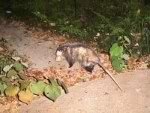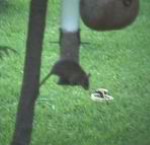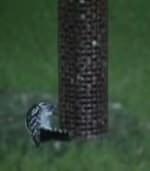 Angie Brown, secretary and webmaster for AOGC, clutching one of the wild pink flamingoes that wander through her yard. |
I live in a city (Arlington, TX) with a population that's getting close to 300,000, in the middle of an urban area with well over a million people (Dallas-Ft. Worth). Yet, despite the continuous paving over of wild places and putting up of buildings, the wildlife is alive and kicking. I apologize in advance for the quality of some of the pictures. Many of them were taken through a window that looks out into the back yard. Among the visitors we've had to our back porch are squirrels, racoons, skunks, mice, rats, lizards, snakes, frogs, toads, and a host of birds.
My yard is in a 30-year-old neighborhood; the trees are mature, which helps provide food and homes for many of the birds and animals.
Jump to:
| Armadillos | Racoons | Squirrels | Other Rodents |
Skunks | Slithery Stuff |
Birds | Wildlife Diary |
Armadillos (top)
During Memorial Day weekend (1999), I discovered that four baby armadillos took up residence under the back deck (I never saw their mother). I guess when they're young, they still feed
 during
the day, and for three days in a row when I'd be working out back between
10 and 11 a.m., out would come all four and start rooting around the place.
They weren't even shy.
during
the day, and for three days in a row when I'd be working out back between
10 and 11 a.m., out would come all four and start rooting around the place.
They weren't even shy.Although armadillos have a bad reputation for digging up people's yards, it's something we've learned to live with. We typically keep the St. Augustine mowed fairly high, and none of the armadillo divets have been deep or wide enough to notice unless you're almost on top of it. They do root around in the flower beds as well, but amazingly enough, nothing has really been damaged. We think it is because the ground in the turf is soft enough that they don't just concentrate on the flower beds. There is a wild area at the back of my property where the adult armadillos eventually make a home, coming into the rest of the yard only to feed, which has helped keep damage in the rest of the yard to a minimum.
 When
we do find the occasional hole in the yard or a crushed plant in the beds,
we just have to remind ourselves that the armadillos are providing a valuable
service: they help control grubs and other damaging pests, while they
aerate the soil.
When
we do find the occasional hole in the yard or a crushed plant in the beds,
we just have to remind ourselves that the armadillos are providing a valuable
service: they help control grubs and other damaging pests, while they
aerate the soil.The most mischief that my four armored friends have caused is with the water garden. We had sunk a galvanized steel watering trough into the ground and filled it with water and stones to provide a place for the birds to drink and bathe. But it soon turned into a favorite of the armadillos, who would fill it full of mud when they played in it. Coupled with the relatively close proximity to the bird feeder anyway, the pump on the fountain would become clogged every few days and cease to run. We dug out the water garden and put it up on the deck away from the bird feeder, and replaced it with an "armadillo bath" that can be poured out and cleaned as necessary.
 |
 |
 |
| Water fountain, pre-armadillo |
Water fountain, during occupation |
New "armadillo bath"; small frog climbing out |
 Other
creatures enjoy the armadillo bath as well. The birds enjoy stopping
there, and I think the stray cats that wander through also use it. The
morning after I installed it, the ground was still soft where I had
filled in the hole left by the water garden. When I went out to check
on it, there was a big butt-print with corresponding paw prints next
to it. I believe it was from a racoon.
Other
creatures enjoy the armadillo bath as well. The birds enjoy stopping
there, and I think the stray cats that wander through also use it. The
morning after I installed it, the ground was still soft where I had
filled in the hole left by the water garden. When I went out to check
on it, there was a big butt-print with corresponding paw prints next
to it. I believe it was from a racoon.
Update Nov. '99: The siblings have moved out from under the porch. The
only one I still see has made a nest back in the woods at the back of
the yard. I watched him gather leaves from further down the hill and
scoot back up the hill and down into his (her?) den. The back yard is
getting aerated quite thoroughly now.
Racoons (top)
We first encountered racoons when we were new to the house (about 4
years ago). We have seen as many as 5 at one time, climbing the tree
on our patio up to the roof. They have eaten a spa cover, and the pneumatic
knobs (twice!) that control the spa blower. We got an aluminum cover,
which seems to do the trick - it looks better than vinyl, too. I'd tell
you where we got it, except that I don't remember and I'm mad at them
anyway for not delivering when they promised. We actually had to fabricate
a spa cover out of plywood and landscaper's fabric the day before our
backyard wedding!

Possums (top)
They come and go. I hadn't seen any for awhile, but tonight I found
one on the back porch, climbing on our barbeque grill. They're not as
skittish as the racoons, so I was able to get my camera, open the window,
and shoot with a flash.
Squirrels (top)
 Well,
what backyard would be complete without them? I took this from inside
the house in the breakfast nook. This is the same tree the racoons and
possums use to go up to the roof and back.
Well,
what backyard would be complete without them? I took this from inside
the house in the breakfast nook. This is the same tree the racoons and
possums use to go up to the roof and back.
They're in the bird feeders a lot, even though we put a baffle on the
pole feeder -- it's only about a 5 foot jump to the top of the feeder
from the roof. We have changed our birdseed to a mixture of safflower
and sunflower (whole, not chipped), and that has slowed them down some.
We keep a feeder back by the woods full of sunflower that is easier
access for them so they don't clean out the one near the house so fast.
 Other
Rodents (top)
Other
Rodents (top)
Before I moved to Texas, I had no idea that rats could climb trees.
I have been educated. The ironic thing about this picture is that my
husband had just opened the front door to go out and put a special rodent-resistant
cage around this bird feeder. Better late than never!
Skunks (top)
During the times when I don't see too much racoon activity, a skunk
will make its way into my yard. My cat (strictly an indoor animal since
she is not to be trusted) seems to know the difference between the different
wildlife that come through. Other cats will be engaged in the famous
cat staring contests. Racoons are largely ignored. Mice and birds on
the back porch are very interesting to her, and she will assume the
stalking position. But skunks are an entirely different story: she can
be walking across the living room and spy a skunk on the porch and stop
mid-stride. She then stands statue-still for awhile, eventually slinking
away into the background ever so slowly.
After all the racoon damage several years ago, we cooperated with my
neighbor to use live traps from the city. Altogether, five racoons,
two possums and an armadillo were caught using stale donuts as bait.
The city then took them away to be released in a park. After that, we
began to see a skunk as a frequent visitor. After some research, I found
out that skunks and racoons compete for the same shelter areas. I tend
to be a little more tolerant of the racoons now.
I have been told by a coworker who caught a skunk in a live trap that
they are the only animals that the city exterminates rather than relocates.
Slithery Friends (top)
 One
of the creatures I really enjoy in my backyard is the anole. There are
lots of them; I usually can't find them if I'm looking for them, but
hardly a time goes by when I'm watering or playing out in the yard that
I don't come upon one. They are beneficial in an organic garden, eating
bugs that might otherwise get out of control.
One
of the creatures I really enjoy in my backyard is the anole. There are
lots of them; I usually can't find them if I'm looking for them, but
hardly a time goes by when I'm watering or playing out in the yard that
I don't come upon one. They are beneficial in an organic garden, eating
bugs that might otherwise get out of control.
Occasionally one gets in the house. I found out first-hand how much
cats like to play with them, an experience I'm not eager to repeat (although
my cat would like to). One time I was in the shower and looked down
to find I was not alone!
We also have small grass snakes and salamanders in our area. Once, a
wood lizard made an appearance, but I haven't seen him since. Frogs,
toads, and snakes also stop by but don't seem to stay long.
Birds (top)
A number of birds are frequent visitors to backyard feeders. Among these
are titmice, doves, Carolina chickadees, blue jays,
 cardinals, woodpeckers and wrens. House sparrows are also commonly found,
and during certain seasons so are grackles. Although some find blue
jays to be bullies, I've observed that they perform a valuable service
to the rest of the birds: they are the first to sound the alarm when
a cat or hawk is spotted, and I have watched them gang up on crows (who
are known to steal eggs from other nests and eat them) and chase them
out of the yard.
cardinals, woodpeckers and wrens. House sparrows are also commonly found,
and during certain seasons so are grackles. Although some find blue
jays to be bullies, I've observed that they perform a valuable service
to the rest of the birds: they are the first to sound the alarm when
a cat or hawk is spotted, and I have watched them gang up on crows (who
are known to steal eggs from other nests and eat them) and chase them
out of the yard.
Woodpeckers are especially attracted to peanut feeders. Shown are pictures
of a downy woodpecker and a red-bellied woodpecker enjoying a treat.
Suet is also a favorite, but I've almost given up on it because the
racoons will inevitably find a way to steal the entire feeder and drag
it under the deck. Other birds that use the peanut feeder are bluejays,
titmice (they were the first to find it), and chickadees. Our house
sparrows and wrens have finally learned how to eat from the peanut feeder
so we'll occassionally find them there. When the grackles move through,
they will also take a stab at the peanut feeders (they'll eat almost
anything). Although I find the occasional squirrel on one, they don't
seem to be able to get at the peanuts so they give up.
Updates and new pictures in Wildlife
Diary
Back to "Critters" section
